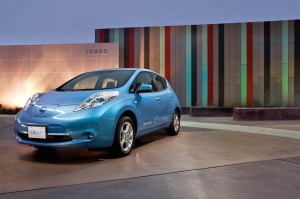While General Motors may be ready to move up the 50-state rollout of its new Chevrolet Volt plug-in hybrid, a new study suggests that California and a handful of other states will dominate demand for battery cars.
In 2015, demand for advanced propulsion vehicles – which includes plug-ins, pure battery-electric vehicles, or BEVs, as well hydrogen-powered fuel-cell vehicles – will reach nearly 35,000 a year in California, about as much as the next five states combined, forecasts the Center for Automotive Research, in Ann Arbor, Michigan.
By that point, there will be an estimated 112,328 of these advanced propulsion vehicles registered in California, compared to 25,746 in Texas, the state projected to have the second-highest demand.
That’s no surprise considering the Golden State is already home to more hybrids, such as the Toyota Prius and Ford Escape Hybrid, than anyplace else. There are currently 50 hybrids for every 10,000 California residents, about twice as many as any other state in the U.S.
That has strongly influenced rollout plans for manufacturers like GM and Nissan, which launched the world’s first mass-market BEV, the Leaf, in December. Most makers plan to begin marketing their battery-based products in California before spreading out across the rest of the country.
That reflects a variety of factors, such as “its position as the largest automobile market in the United States,” said the CAR study’s authors, “as well as its relatively high penetration of hybrids and a regulatory environment conductive to electric vehicle adoption.”
While California regulators have steadily tightened the screws on traditional automotive technologies, they have strongly encouraged the adopted of battery-based vehicles, offering incentives of up to $5,000 per vehicle and access to commuter lanes, while also pushing for the placement of public battery car charging stations.
But things could change, lead researcher Kim Hill cautioned, noting “many factors could affect deployment and annual market share.” Those include new government incentives, as well as fleet purchases and new technologies that could make battery power more appealing.
Indeed, California is now just one of a dozen states that have approved incentives for battery vehicles, some offering as much as $6,000 to those who qualify – on top of the current $7,500 federal tax credit.
Numerous cities and states are also pushing for the expansion of the public charging infrastructure, Chicago just last week revealing plans for a network of stations that will include both Level II chargers – which typically need around 8 hours for a vehicle like Leaf – as well as 440-volt Level III charging stations that could cut times to less than 30 minutes.
According to the CAR study, the 10 states expected to sell the most advanced propulsion vehicles in 2015 are:
- California 33,531
- Texas 7,685
- New York 7,520
- Florida 7,406
- Illinois 5,337
- Virginia 5,097
- Washington 4,976
- Pennsylvania 4,742
- Massachusetts 4,319
- New Jersey 3,913
With most analysts forecasting the overall U.S. automotive market to climb back into the 15 million to 16 million range by mid-decade, advanced propulsion vehicles will likely account for less than 1% of the total automotive market.
The study, meanwhile, suggests that barring some significant steps – or other factors, such as a massive rise in oil prices – the Obama Administration will fall short of its goal of putting 1 million battery cars on the road.

